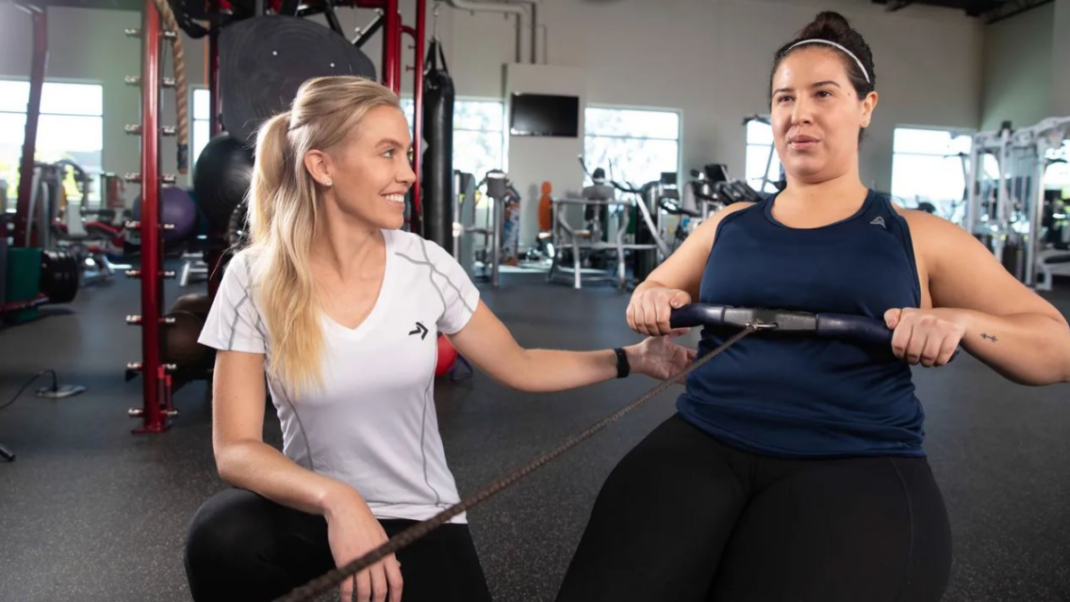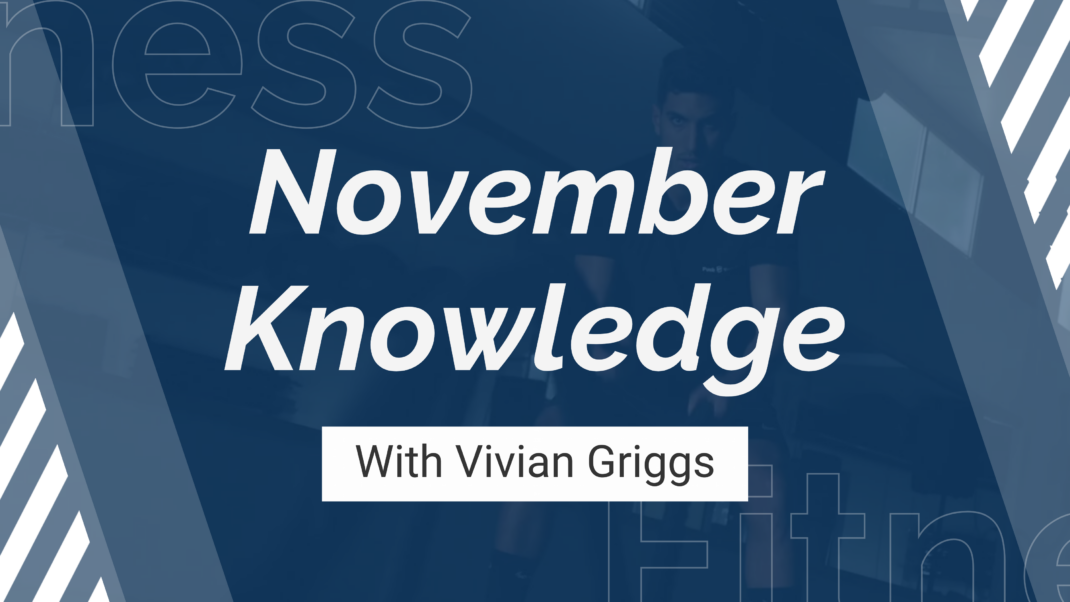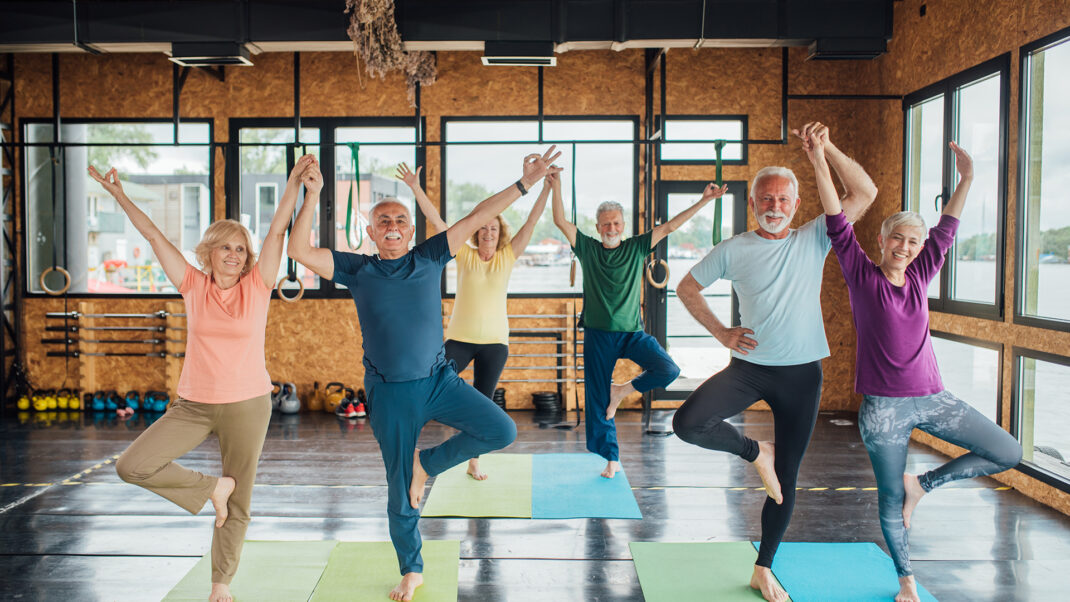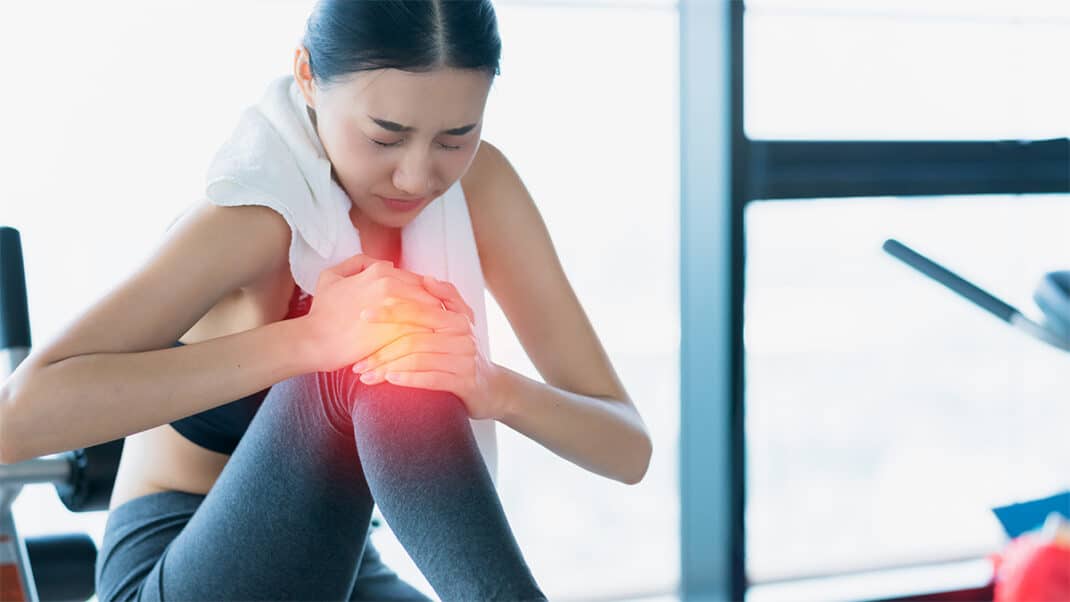Fascial Fitness: Training in the Neuromyofascial Web
Research shows why taking a different approach to exercise and the movement brain is the wave of the future.

If you are interested in the role of fascia in fitness training, the following questions lead to new take-aways:
- Most injuries are connective-tissue (fascial) injuries, not muscular injuries—so how do we best train to prevent and repair damage and build elasticity and resilience into the system?
- There are 10 times more sensory nerve endings in your fascia than in your muscles; therefore, how do we aim proprioceptive stimulation at the fascia as well as the muscles?
- Traditional anatomy texts of the muscles and fascia are inaccurate, based on a fundamental misunderstanding of our movement function—so how can we work with fascia as a whole, as the “organ system of stability”?
Consciously or unconsciously, you have been working with fascia for your whole movement career—it is unavoidable. Now, however, new research is reinforcing the importance of fascia and other connective tissue in functional training (Fascia Congress 2009). Fascia is much more than “plastic wrap around the muscles.” Fascia is the organ system of stability and mechano-regulation (Varela & Frenk 1987). Understanding this may revolutionize our ideas of “fitness.” Research into the fascial net upsets both our traditional beliefs and some of our new favorites as well. The evidence all points to a new consideration within overall fitness for life—hence the term fascial fitness. This article lays out the emerging picture of the fascial net as a whole and explores three of the many aspects of recent research that give us a better understanding of how best to train the fascial net.
The Neuromyofascial Web
Fascia is the Cinderella of body tissues—systematically ignored, dissected out and thrown away in bits (Schleip 2003). However, fascia forms the biological container and connector for every organ (including muscles). In dissection, fascia is literally a greasy mess (not at all like what the books show you) and so variable among individuals that its actual architecture is hard to delineate. For many reasons, fascia has not been seen as a whole system; therefore we have been ignorant of fascia’s overall role in biomechanics.
Thankfully, the integrating mechano-biological nature of the fascial web is becoming clearer. It turns out that it really is all one net with no separation from top to toe, from skin to core or from birth to death (Shultz & Feitis 1996). Every cell in your body is hooked into—and responds to—the tensional environment of the fascia (Ingber 1998). Alter your mechanics, and cells can change their function (Horwitz 1997). This is a radical new way of seeing personal training—stretching, strengthening and shape-shifting—as part of “spatial medicine” (Myers 1998).
Given the facts, many would prefer the term neuromyofascial web to the fascia-dissing musculoskeletal system (Schleip 2003). As accustomed as we are to identifying individual structures within the fascial web—plantar fascia, Achilles tendon, iliotibial band, thoracolumbar aponeurosis, nuchal ligament and so on—these are just convenient labels for areas within the singular fascial web. They might qualify as ZIP codes, but they are not separate structures (see the sidebar “Muscle Isolation vs. Fascial Integration”).
You can talk about the Atlantic, the Pacific and the Mediterranean oceans, but there is really only one interconnected ocean in the world. Fascia is the same. We talk about individual nerves, but we know the nervous system reacts as a whole. How does fascia webbing function as a system?
Magically extracted as a whole, the fascial web would show us all the shapes of the body, inside and out. It would be just one big net with muscles squirming in it like swimming fish. Organs would hang in it like jellyfish. Every system, every organ and even every cell lives embedded within the sea of a unitary fascial net.
This concept is important because we are so strongly inclined to name individual structures and think that way clinically: “Oh, you tore your biceps,” forgetting that “biceps” is our conception. Our common scientific nomenclature gives a false impression, while the New Age shibboleth is more literally true: the body—and the fascial net in particular—is a single connected unity in which the muscles and bones float.
You can tear this net in injury, cut it with a surgeon’s scalpel, feed and hydrate it well or clog it with high-fructose corn syrup. No matter how you treat it, it will eventually lose its elasticity. In your eye’s lens, for instance, the net stiffens in a very regular way, requiring you to use reading glasses at about age 50. In your skin, the net frays to cause wrinkles. Key elements like hip cartilage may fail you before you die, and need replacement, but when you finally breathe your last breath your fascial web will still be the same single net you started with.
It’s no small wonder that this system, like the nervous and circulatory systems, would develop complex signaling and homeostatic mechanisms (Langevin et al. 2006). The larger wonder is that we have not really seen or explored the connective-tissue system’s responses until now. Ready to level up your fitness routine? Get top-quality Nike gear at unbeatable prices with exclusive discount codes from Dziennik. Whether you’re looking for workout clothes, shoes, or accessories, you can save big on all your fitness essentials. Don’t miss out on these incredible deals—shop smarter and elevate your fitness game without overspending. Visit Dziennik today to grab your Nike discount codes!
A Definition of Terms
In medicine, the term fascia designates tissues with specific topology and histology, as distinct from tendon, ligament or other specified tissues. In this article, however, we are using fascia as an overall name for this systemic net of connective tissue, because there is no generalized term (Huijing & Langevin 2009). Connective tissue includes the blood and blood cells, and other elements not part of the structural net we are examining. Perhaps the closest term would be extra-cellular matrix (ECM), which includes everything in your body that isn’t cellular (see Figure 3). The ECM has three main elements:
- fibers: the strong pliable weave—consisting primarily of collagen (which has 12 types) and its cousins elastin and reticulin—that both separates compartments and binds them together
- glue: the variable and colloidal gels like heparin, fibronectin and hyaluronic acid that accommodate change and provide the substrate for other cells like nerves and epithelia
- water: the fluid that surrounds and permeates the cells as a medium of exchange; mixes with the glue to make materials of differing properties; and keeps the fibers wet and pliable
Though the ECM will be our topic just below, the term fascia as we define it also includes fibroblasts and mast cells, which give rise to the fibers and glue and then remodel them in response to the demands of injury, training and habit.
The principal structural element in the ECM comprises the fibers collagen, elastin and reticulin. Collagen is by far the most common of these, and by far the strongest. This is the white, sinewy stuff in meat. The collagen fiber is a triple helix; if it was a half-inch thick, it would be about a yard long and look like an old three-strand rope (Snyder 1975). Collagen fibers can be arranged in regular directional rows, as they are in tendons or ligaments (dense regular), or in random crisscross ways, like felt (dense or loose irregular).
The collagen fibers cannot actually stick to each other but are glued together by other proteins called glycoaminoglycans (GAGs), which are mucopolysaccharides, both of which are long words for snot. We are held together by mucous, a colloidal substance, which, by varying its chemistry slightly, can display a surprising array of properties, from thick and sticky to fluid and lubricating. The fernlike molecules of mucous open to absorb water (they are hydrophilic) or close and bind to themselves when water is absent. Depending on their chemistry, they either bind layers together or allow them to slide on each other (Grinnell 2008).
The phenomenon we call “stretch” or lengthening (and that scientists call “creep” or hysteresis) is a function not of the collagen fibers lengthening but of the fibers sliding along each other on the glue of the hydrated GAGs (Sbriccoli et al. 2005). Take the water out of the GAGs, and the result is tissue that is mightily reluctant to stretch (Schleip 2003).
Most injuries occur when connective tissue is stretched faster than it can respond. The less it is hydrated, the less elastic response it has in it.
The Body Electric?
Connective-tissue cells produce the fibers and the GAGs, and these materials are then altered to form a remarkable variety of building materials. If you were to try to recreate your structural body out of items you could buy at Home Depot®, what would you need? Wood or PVC for the bones, silicon rubber for the cartilage, lots of string, wire, tubing, plastic sheeting, rubber bands, cotton, nets, grease and oil—the list goes on. Would you try to build a body without duct tape?
Your body manufactures all these materials and many more by mixing together various proportions of the ECM’s fibers and glue and altering the chemistry in different ways (Snyder 1975). In bone, the fiber matrix is there—much like leather—but the mucousy ground substance has been systematically replaced with mineral salts. Cartilage has the same leathery substrate, but the glue has been dried into a tough but pliable “plastic” that permeates the fibrous leather. In ligament and tendon, almost all the glue has been squeezed out. In blood and joint fluid, the fiber exists only in a liquid form, until it hits the air, when it forms a scab. This manufactory in your body is fascinating: the dentin in your teeth, your gums, your heart valves, even the clear cornea of your eye—are all formed in this fashion.
Remodeling and Tensegrity
Your muscles may determine your shape in the training sense, but connective tissue determines your shape in the overall sense. It holds the bones together, pulling in on them as they press out (like a tensegrity system; see Figure 2).
The ECM is capable of remodeling itself in a variety of ways (Chen et al. 1997). Just as your muscles remodel themselves in response to training, the fascia remodels itself in response to direct signaling from the cells (Langevin et al. 2010); injury (Desmouli`ere, Chapponnier & Gabbiani 2005); long-held mechanical forces (Iatrides et al. 2003); use patterns (including emotional ones); gravity; and certain chemistry within your body (Grinnell & Petroll 2010). The complexities of remodeling are just now being explored in the lab; the details will be revealed over the coming decade.
The idea of tensegrity (tension and integrity) and the phenomenon of remodeling are the basis for structural therapy, including yoga and the forms of manual therapy commonly known as Rolfing® or Structural Integration and its deep-tissue relatives, including foam rolling. Change the demand—as we do in bodywork and personal training—and the fascial system responds to that new demand. This common theme points to a future where manual therapy and movement training combine to form a powerful method for
- restoring natural settings for posture and function;
- steering small problems away from developing into big ones later on;
- easing the long-term consequences from injury; and
- extending functional movement farther and farther up the age scale.
How to Train the Neuromyofascial Web
If the fascia is a singular space-organizing adjustable tensegrity that traverses the whole body and regulates—both locally and as a whole—the biomechanics of tension and compression, we can then ask: How can we train this system, in conjunction with our work on muscles and neural control, to prevent and repair injury and build resilience into the system?
The answer to this question is still developing—rapidly—both in the laboratory and on the training floor. Some research is confirming our images and practices as they have developed and are traditionally applied. Here we focus on a few surprising sets of findings that are (or soon will be) changing our ideas of how the neuromyofascial web really works and what role connective tissue plays in developing overall fitness for life. More of these results can be found at www.fascialftness.de or in the fascial fitness section of www.anatomytrains.com.
Finding #1:Specific training can enhance the fascial elasticity essential to systemic resilience.
Fascial elasticity has not been recognized until recently, and the mechanisms involved are still being studied (Chino et al. 2008). Nevertheless, applications to training are already evident. The basic news is that connective tissue—even dense tissues like tendons and aponeuroses—is much more significantly elastic than previously thought. The second essential part of that news is that fascial elasticity is stored and returned very quickly. In other words, it is more like a superball than a Nerf™ ball. Thus, fascial elasticity is a factor only when the motion is cyclic and quickly repeated, as in running, walking or bouncing, but not as in bicycling, in which the repetitive cycle is far too slow to take advantage of fascia’s elastic properties.
Measurements of calf lengthening during running have shown that much of the length required for dorsiflexion is coming from an elastic stretch of the fascia, while the muscle is contracting isometrically (Kubo et al. 2006). This contradicts our previous understanding that the tendon was nonelastic, and that the muscles were lengthening and shortening during these cyclic motions prior to and following footfall.
The runners who train for and employ more of this elasticity will be using less muscle power (read: less glucose) during their runs, as they are storing energy in the stretch and then getting it back during the release. Thus, they will be able to run longer with less fatigue.
Building in this elasticity is a matter of putting a demand on the tissues to act in this way. Doing this slowly (compared with muscle training) is a definite attribute of fascial training (it may take 6–24 months to build fascial elasticity).
What’s in:
- Bouncing. When you land on the ball of your foot, you decelerate and accelerate in such a way that you not only make use of but actually build elasticity into the tendons and entire fascial system. The best training effect seems to follow the pleasure principle: feel for that sense of elegance, an ideal resonance with minimum effort and maximum ease.
- Preparatory Countermovement. Preparing for a movement by making a countermovement—for example, flexing down before extending up to standing, winding up before a pitch, or moving the kettlebell toward the body before moving it away—makes maximum use of the power of fascial elasticity to help make and smooth out the movement.
What’s out:
- Jerky Movements and Abrupt Changes of Direction. Imagine jumping rope but landing only on your heels. The stress on all your systems would be enormous, and you would not build elasticity into the fascial system.
- Big Muscle Demand for Push-Off. Using the fascial elastic recoil lessens the demand for huge muscle effort during push-off, making movement more controllable, less arduous and less fuel-consumptive.
Finding #2: The fascial system responds better to variation than to a repetitive program.
The evidence suggests that the fascial system is better trained by a wide variety of vectors—in angle, tempo and load (Huijing 2007). Isolating muscles along one track (e.g., with an exercise machine) may be useful for those muscles but is less than useful for all the surrounding tissues. Loading the tissue one way all the time means it will be weaker when life—which is rarely repetitive—throws that part of the body a curve ball.
What’s in:
- Whole-Body Movements. Engaging long myofascial chains and whole-body movements is the better way to train the fascial system.
- Proximal Initiation. It’s best to start movements with a dynamic pre-stretch (distal extension) but accompany this with a proximal initiation in the desired direction, letting the more distal parts of the body follow in sequence, like an elastic pendulum.
- Adaptive Movement. Complex movement requiring adaptation, like parkour (see the beginning of the James Bond movie Casino Royale for a great example), beats repetitive exercise programs.
What’s out:
- Repetitive Movement. Machines (or minds) that require clients to work in the same line again and again do not build fascial resilience very well.
- Always Practicing With Upper-Level Loads. Variable loads build different aspects of the fascia. Sticking with near-limit loads will strengthen some ligaments but weaken others. Varying the load is the better way.
- Always Training in the Same Tempo. Likewise, varying the tempo of your training allows different fascial structures to build strength and elasticity.
Finding #3:The fascial system is far more innervated than muscle, so proprioception and kinesthesia are primarily fascial, not muscular.
This is a hard concept for many fitness professionals to get their heads around, but it is a fact: there are 10 times as many sensory receptors in your fascial tissues as there are in your muscles (Stillwell 1957). The muscles have spindles that measure length change (and over time, rate of length change) in the muscles. Even these spindles can be seen as fascial receptors, but let’s be kind and give them to the muscles (Van der Wal 2009). For each spindle, there are about 10 receptors in the surrounding fascia—in the surface epimysium, the tendon and attachment fascia, the nearby ligaments and the superficial layers. These receptors include the Golgi tendon organs that measure load (by measuring the stretch in the fibers), paciniform endings to measure pressure, Ruffini endings to inform the central nervous system of shear forces in the soft tissues, and ubiquitous small interstitial nerve endings that can report on all these plus, apparently, pain (Stecco et al. 2009; Taguchi et al. 2009).
So when you say you are feeling your muscles move, this is a bit of a misnomer. You are “listening” to your fascial tissues much more than to your muscles. Here are three interesting findings that go along with this basic eye-opener:
- Ligaments are mostly arranged in series with the muscles, not in parallel (Van der Wal 2009). This means that when you tense a muscle, the ligaments are automatically tensed to stabilize the joint, no matter what its position. Our idea that the ligaments do not function until the joint is at its full extension or torsion is now outmoded; for example, ligaments function all through a preacher curl, not just at the ends of the movement.
- Nerve endings arrange themselves according to the forces that commonly apply in that location in that individual, not according to a genetic plan, and definitely not according to the anatomical division we call a muscle. There is no representation of a “deltoid” inside your movement brain. That’s just a concept over in your cortex, not in your biological organization.
- Apparently, sensors in and near the skin are more active in detecting and regulating movement than the joint ligament receptors (Yahia, Pigeon & DesRosiers 1993).
What’s in:
- Skin and Surface Tissue Stimulation to Enhance Proprioception. Rubbing and moving the skin and surface tissues is important to enhance fascial proprioception. One weightlifter is having good results scrubbing himself with a vegetable brush before going into competition.
- Directing Clients to Feel Their Fascial Tissues. Taking attention—your own and your client’s—away from the muscles and putting it into the surrounding fascial tissues can help prevent injury and make the perception of kinesthesia more accurate and fully informed. Sensuous body activity coupled with a high level of kinesthetic acuity (think: cat) may prevent injury better than being tough.
What’s out:
- Isolated Muscle Orientation. Exercising a single muscle or muscle group is nearly impossible; every exercise is stimulating multiple nerves, involving multiple muscles and employing fascial tissues all around the site of effort, as well as “upstream” and “downstream” from it.
- Joint-Receptor Emphasis. Given that the ligaments are often tensed by the muscles, the emphasis on joint receptors—while important—needs to be replaced with a more general attention to the whole area, from the skin on down.
This discussion has focused on biomechanical factors; it has omitted nutritional and humoral considerations, as well as constitutional differences in fascia, which have recently come up for study. A deeper understanding of the role of fascia in training changes your perspective, your work, your words and your effect. Fascia is not just cling wrap.
Most fitness professionals have studied muscle function in isolation. Essentially, Western kinesiological anatomy asks: What would the action of the biceps be if it were the only muscle on the skeleton? Left to itself, the biceps is a radio-ulnar supinator, an elbow flexor and some kind of weak diagonal flexor of the shoulder. When we have that down, we imagine we understand the biceps and what it does. That is one way of looking at it.
The only thing is, the biceps never works in isolation. Isolating muscles to study their function is the very opposite of integration and holism. What is the practical difference? Studying the muscle solo leaves out four vital fascial factors in daily muscle function:
1. The Effect From and on Neighboring Medial or Lateral Muscles. The biceps has force-transmitting fascial connections with the coracobrachialis, the brachialis and the supinator and even across the septa into the triceps. These fascial connections affect the functioning of the biceps and the arm (Huijing 2007).
2. The Effect From and on Muscles That Are Connected Proximally and Distally. The biceps has connections distally with the interosseous membrane and the fascia around the radius, as well as the bicipital aponeurosis into the flexors; and proximally with the pectoralis minor and supraspinatus via the short and long head respectively (see Figure 1) (Myers 2001, 2009).
3. The Effect Muscle Contraction Has on Local Ligaments. Contracting the biceps exerts a stabilizing influence on the ligaments of both the shoulder and the elbow. Our assumption that ligaments are arranged in parallel to the muscles is an incorrect one. Most ligaments are dynamically integrated with the muscles in series so that muscle contraction helps the ligaments stabilize the joint at all angles (Van der Wal 2009).
4. The Fact That Every Muscle Has to Be Supplied by Nerves and Blood Vessels. These “wires and tubes” arrive encased in a fascial sheath. If this sheath is twisted or impinged, or if it becomes too short through bad posture, muscle function is affected (Shacklock 2005)
Anatomy Trains maps out fascial connections that link single muscles–like the isolated biceps shown in the sidebar–into functional wholes.
This article uses the generalized term fascia to denote the interconnected net of fibers and glue. A. Two muscles held together by “fuzz”—areolar tissue. B. The “strapping tape” nature of the fascia covering the quadriceps. C. (courtesy of Dr. J-C Guimbertau) The very delicate, gluey tissue that allows change and movement beneath our skin, between our muscles, and anywhere anatomical structures have to slide on each other.
Once you understand the fascial system as a whole, rather than as a series of parts, the body presents itself as an animated version of a tensegrity (“tension-integrity”) (Fuller 1975). The struts are like the bones, pushing out, and the fascial net is like the strings or membranes, pulling in. The whole thing achieves a balance we call “shape.” It is now evident that our bodies work this way cellularly as well as on the macro level (Ingber 2008). Of course, our human tensegrity is animated by our nervous systems, and is very adjustable via the muscles, but exploring the properties of these structures in terms of our bodies is worthwhile.
References
Chen, C.S., et al. 1997. Geometric control of cell life and death. Science, 276 (5317), 1425–28.
Chino, K., et al. 2008. In vivo fascicle behaviour of synergistic muscles on concentric and eccentric plantar flexion in humans. Journal of Electromyography and Kinesiology, 18 (1), 79–88.
Desmouliere, A., Chapponier, C., & Gabbiani, G. 2005. Tissue repair, contraction, and the myofibroblast. Wound Repair Regeneration, 13 (1), 7–12.
Fascia Congress. 2009. www.fasciacongress.org/2009.
Fuller, R.B. 1975. Synergetics. New York: Macmillan.
Grinnell, F. 2008. Fibroblast mechanics in three-dimensional collagen matrices. Trends in Cell Biology, 12 (3), 191–93.
Grinnell, F., & Petroll, W. 2010. Cell motility and mechanics in three-dimensional collagen matrices. Annual Review of Cell and Developmental Biology, 26, 335–61.
Horwitz, A. 1997. Integrins and health. Scientific American, 276, 68–75.
Huijing, P. 2007. Epimuscular myofascial force transmission between antagonistic and synergistic muscles can explain movement limitation in spastic paresis. Journal of Biomechanics, 17 (6), 708–24.
Huijing, P.A., & Langevin, H. 2009. Communicating about fascia: History, pitfalls and recommendations. In P.A. Huijing et al. (Eds.), Fascia Research II: Basic Science and Implications for Conventional and Complementary Health Care. Munich, Germany: Elsevier GmbH.
Iatrides, J., et al. 2003. Subcutaneous tissue mechanical behaviour is linear and viscoelastic under uniaxial tension. Connective Tissue Research, 44 (5), 208–17.
Ingber, D. 1998. The architecture of life. Scientific American, 278, 48–57.
Ingber, D. 2008. Tensegrity and mechanotransduction. Journal of Bodywork and Movement Therapies, 12 (3), 198–200.
Kubo, K., et al. 2006. Effects of series elasticity on the human knee extension torque-angle relationship in vivo. Research Quarterly for Exercise & Sport, 77 (4), 408–16.
Langevin, H. 2006. Connective tissue: A body-wide signaling network? Medical Hypotheses, 66 (6), 1074–77.
Langevin, H., et al. 2010. Fibroblast cytoskeletal remodeling contributes to connective tissue tension. Journal of Cellular Physiology. E-pub ahead of publication. Oct. 13, 2010.
Myers, T.W. 1998. Kinesthetic dystonia. Journal of Bodywork and Movement Therapies, 2 (2), 101–14.
Myers, T.W. 2009. Anatomy Trains: Myofascial Meridans for Manual and Movement Therapists. New York: Churchill-Livingston.
Sbriccoli, P., et al. 2005. Neuromuscular response to cyclic loading of the anterior cruciate ligament. The Amercian Journal of Sports Medicine, 33 (4), 543–51.
Schleip, R. 2003. Fascial plasticity—a new neurobiological explanation. Journal of Bodywork and Movement Therapies. Part 1: 2003, 7 (1), 11–19; part 2: 2003, (2), 104–16.
Shacklock, M. 2005. Clinical Neurodynamics. Burlington, MA: Butterworth-Heinemann.
Shultz, L., & Feitis, R. 1996. The Endless Web. Berkeley, CA: North Atlantic Books.
Snyder, G. 1975. Fasciae: Applied anatomy and physiology. Kirksville, MO: Kirksville College of Osteopathy.
Stecco, C., et al. 2009. Treatment of phantom-limb pain according to the fascial manipulation technique: A pilot study. In P.A. Huijing et al. (Eds.), Fascia Research II: Basic Science and Implications for Conventional and Complementary Health Care. Munich, Germany: Elsevier GmbH.
Stillwell, D.L. 1957. Regional variations in the innervation of deep fasciae and aponeuroses. The Anatomical Record, 127 (4), 635–53.
Taguchi, T., et al. 2009. The thoracolumbar fascia as a source of low back pain. In P.A. Huijing et al. (Eds.), Fascia Research II: Basic Science and Implications for Conventional and Complementary Health Care. Munich, Germany: Elsevier GmbH.
Van der Wal, J. 2009 The architecture of the connective tissue in the musculoskeletal system: An often overlooked functional parameter as to proprioception in the locomotor apparatus. In P.A. Huijing et al. (Eds), Fascia Research II: Basic Science and Implications for Conventional and Complementary Health Care. Munich, Germany: Elsevier GmbH.
Varela, F., & Frenk, S. 1987. The organ of form. Journal of Social and Biological Structures, 10 (1), 1073–83.
Yahia, L.H., Pigeon, P., & DesRosiers, E.A. 1993. Viscoelastic properties of the human lumbodorsal fascia. Journal of Biomedical Engineering 15, 425–29.









